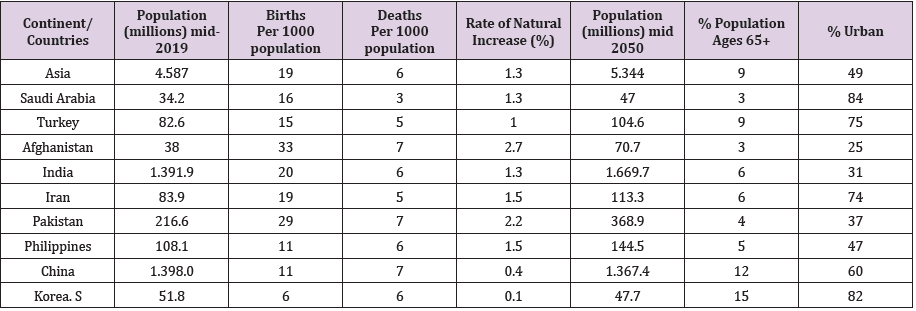Abstract
Population aging as a new phenomenon is widely and comparatively appearing in Asia. The event first emerged in industrial world, but gradually, through transformation of norms and values, Asian countries too adopted the new values. Through change and rise in economic growth and educational upheaval, many Asian countries are currently facing population aging, but not sufficient nursing. The processes of modernization and industrialization have played major roles in aging of the Asian countries. However, aging being a natural or passive process, involves social exclusion in societies [1]. Despite the obvious connections between demography and sociology, it is surprising that these two disciplines have tended to develop as separate and distinct approaches to human society [2,3]. Despite the above argument, population indicators can widely analyze the population change.
Keywords: Aging; Nursing; Asia; Sociology; Demography
Discussion
Economic growth, which in itself leads to development, also
affects the population in various ways; That is, a movement in
which population growth, middle age, population aging, population
health, and so on are affected. Over the last two centuries, economic
growth has generally affected the developed countries of Western
Europe; In other words, population growth has decreased in those
communities, and as a result, a smaller population has emerged in
these communities. Such a situation has affected the lives of citizens
in those communities in various ways, economically and socially,
and the quality of life; That is, a phenomenon that itself affected
other demographic indicators such as life expectancy, reduction
of mortality, etc. in those communities first and foremost in other
parts of the world. Also, the middle age index increases widely
under the influence of economic growth. The middle age index
refers to the point at which 50% of the population is at that age. For
example, today in industrialized countries the median age index is
over 32 years old. In non-industrial societies, however, the median
age index is generally below the age of 20.
Population aging, as one of the achievements of economic
growth, first occurred in industrialized countries and gradually
spread to other societies to some extent. Also, economic growth has
led to better health of the population in different age groups. Hence,
economic growth generally affects other social and demographic
indicators to a large extent. The Asian region or continental Asia
with a population of 4.6 billion in 2020 [4,5], has also undergone
extensive changes in the years since 1950, as far as aging and
economic growth are concerned. This means that the demographic
events of industrial societies have gradually affected Asian societies
since the mid-twentieth century. Most of the changes due to
economic growth and demographic change are related to East
Asian countries. In the words of Indian Population Minister Karan
Singh at the 1974 Bucharest Population Conference, “development
is the best means of prevention.”
This means that when countries pursue economic development,
they naturally and regularly modify their population growth, or in
other words, following the economic development of the population,
it also modifies in various forms. Improving the life expectancy
of the population, middle age of the population, reduction of
population mortality and the like are among the things that are
achieved under the influence of economic growth. The process or
economic growth first happened to Japan, South Korea, China and
many other countries. In such a situation, demographic planners in
the long run must consider the needs of the population. This means
that in the context of increasing life expectancy, for example up to
the age of 80, the planning process in a country must anticipate the
food, health, housing, employment, etc. needs of the population up
to the age of 80 or older (Table 1).
Table 1:Selected Population Variables of Some Asian Countries 2019.
Note: Source: 2019 World Population Data Sheet
Fertility decline, as a determinant of population, also occurs naturally following economic growth; That is, a situation in which many of the people involved in economic growth at an older age marry and subsequently have children. This situation is also evident in many Asian societies today.
Conclusion
Due to industrial and economic growth, population aging is currently occurring in many parts of Asia. But sufficient nursing programs are not put into practice to nurse the increasing aging people. Many aging people in Asia depend on their children and grandchildren for nursing and care during their old age. Countries like Japan and South Korea have put into effect satisfactory plans to take care of their elderly people. So, Asia widely needs to plan and invest on its growing aging people. Pensions and insurance coverage are highly in need to be practiced in Asia. Income shortage is the number one problem of many aging people in Asia.
References
- Turner BS (2001) Society and Culture, London, Sage.
- Wringley EA Shofield R (1981) The population History of England 1541-1871: A Reconstruction, London, Amold.
- Coleman D, Salt J (1992) The British Population, Oxford, Martin Robertson.
- (2019) World Population Data Sheet. PRB, Washington DC.
- (2020) World Population Data Sheet. Population Reference Bureau, Washington DC, USA.

 Mini Review
Mini Review
